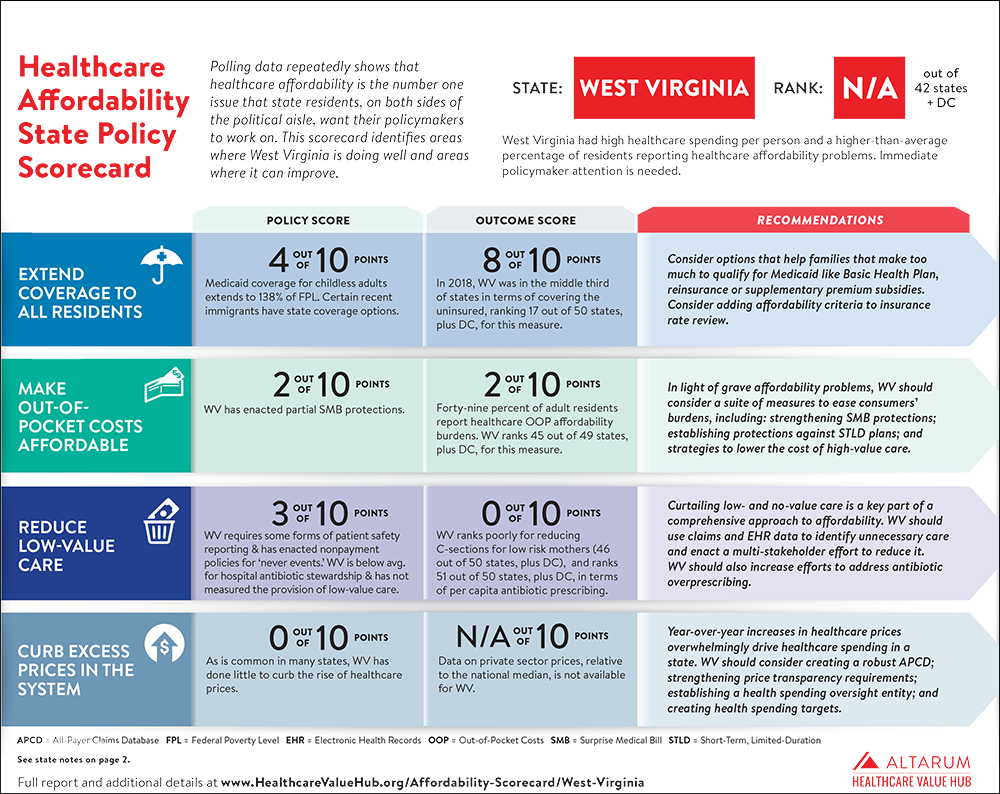State News
Clinic Highlights Major Need for Affordable Medical Care in West Virginia
More than 500 people in need of medical care showed up for free treatment Saturday at West
Virginia Health Right’s first ever #WeCareWV day, reports WV Public Broadcasting. Health
Right CEO Angie Settle says the response indicates how desperately West Virginia’s working
poor need affordable medical care. Dental and vision care were the most requested services.
State Moves Ahead on Medicaid Extension to Improve Maternal Health
West Virginia has passed legislation to extend Medicaid coverage to low-income women up to one year after giving birth, reports U.S. News & World Report. The state’s Governor indicated that the state’s health department will opt into the state plan option indicated in the American Rescue Plan, noting that the state’s population has many lower-income families and pregnant women in need of comprehensive health coverage.
West Virginia's Prescription Transparency Law Can Address Rising Drug Costs
Understanding how prescription drug prices are set will allow both patients and states to make more informed decisions about whether prices are excessive, as well as introduce some rationality and evidence into the healthcare system, according to a new report from the West Virginia Center on Budget and Policy. During the 2020 legislative session, West Virginia passed a drug transparency law requiring manufacturers to report prices, and research and development costs and justify price increases. In addition, all health plan insurers in the state are required to report the 25 most frequently prescribed prescription drugs, the percent increase in annual net spending for prescription drugs, and the percent increase in premiums that were attributable to prescription drugs. Authors note that the state could consider expanding the law to include pharmacy benefit managers and appointing a prescription drug affordability board with the power to regulate drug prices.
COVID Tests Are Free, Except When They're Not
Davis Abel lives with lupus, a chronic autoimmune disease that makes her more susceptible to catching a virus or an infection. After developing symptoms of COVID-19, she made an appointment with her primary care doctor, where she was told she needed to have tests done to rule out other respiratory diseases and to make her eligible for the COVID-19 test. In this edition of Kaiser Health News' Bill of the Month, it is revealed how Davis became liable for an astounding $536.46 for a primary care appointment and testing through two in-network sites. Though Congress has passed legislation expanding the number of tests and services insurers must cover at no cost, gaps remain that expose patients to surprise medical bills. The guidelines state that insurers are required to cover the cost of an appointment without cost sharing only if the doctor orders or administers a COVID-19 test. So, because Davis' doctor performed a baragge of other tests due to a national shortage, but not for COVID-19, she was on the hook for the high medical bill.
State Agencies Partner to Provide Free Transport to Recovery Treatment
West Virginia state agencies have partnered to offer free public transportation to and from treatment and recovery services for individuals with Opioid Use Disorder, according to Appalachia Health News. The new initiative is part of the state’s Opioid Response Grant that was award by the United States Substance Abuse and Mental Health Services Administration. This initiative will increase hours and add additionally off-route locations for individuals in need.
New Law Allows Emergency Refills of Crucial Medication
A new West Virginia will enable residents to access life-saving medicines when their supply runs out, the prescription is expired and the doctor can’t be reached to 'OK' it, according to WV Metro News. HB 2524 grants pharmacists the discretion to fill those prescriptions under specified conditions and certain circumstances. This bill allows pharmacists, under specified conditions, to extend 30-day prescriptions to 90 day and requires payers to cover the cost if it is consistent with the patient's benefit plan.
Revamping Soda Tax Could Add Millions to State Budget, Report Finds
A new report from the West Virginia Center on Budget and Policy suggests the state could add close to $100 million a year to its budget by modernizing and increasing the soda tax, according to an article in The State Journal. The new revenue could go to fund Medicaid, the Public Employees Insurance Agency or even programs aimed at preventing childhood obesity. While lower-income populations may be disproportionately affected by a soda tax, they are also disproportionately affected by overweight, obesity, and resulting health conditions. If the revenues are earmarked to be put back into these same communities, the results will ultimately be progressive. To balance the budget in 2017, Gov. Jim Justice unveiled a health initiative that, among other things, would have updated the state’s soda tax to be 1 cent per ounce of soda. Lawmakers balanced the budget, with its $500 million hole, without signing on to Justice’s plan.
Report Finds Opioid Crisis Costs West Virginia 8.7 Billion
Senator Joe Manchin’s office released a report today that found in 2016, the economic cost of the opioid epidemic in West Virginia was more than $8.7 billion, according to an article in WV Public Broadcasting. The brief from Manchin’s office relied heavily on the CEA report to draw conclusions about the financial impact on West Virginia. The council looked at the cost of opioid-related fatalities, healthcare spending, addiction treatment, criminal justice and lost productivity, concluding that fatalities resulting from overdose were the single most costly effect of the opioid epidemic.
The Real Lesson from the West Virginia Strike
In the recent teachers strike in West Virginia, teachers were striking because of low pay increases, however they were also upset over rising healthcare costs that takes up any pay increases that are received, according to a story in U.S. News & World Report. While the teachers have agreed to return to work for a 5 percent pay increase, in the long run that may prove to be insufficient as healthcare costs rise faster than inflation. The story argues that the real lesson to be learned from West Virginia’s teacher strike is that it is time to get serious about bringing down healthcare costs.
WV Medicaid Covers an Innovative and Less Costly Treatment Model for Opioid-Affected Infants
In a new treatment option for infants suffering from neonatal abstinence syndrome (NAS), West Virginia has been granted a new financing approach for these infants, according to the National Academy for State Health Policy. West Virginia has been hit particularly hard by the opioid epidemic, and the new treatment option offers treatment for infants suffering from less severe symptoms to be treated in a special care nursery referred to as NAS treatment centers. By introducing a bundle payment for NAS services outside the hospital setting, West Virginia is able to offer a lower cost option for treatment of these infants.
Overburdened Mental Health Providers Thwart Police Push For Drug Treatment
West Virginia has a severe shortage of behavioral health professionals who can help people beat their addictions to drugs and alcohol, according to this Stateline report. And with hundreds of people outside of the criminal justice system on waiting lists for treatment, county mental health officials are hesitant to make room for drug users when not enough beds and treatment services are available for existing clients, according to Jim Johnson, West Virginia’s recently appointed drug czar.
Coal Miners Concerned Over Losing Health Benefits
Many retired coal miners are at risk for losing their health benefits, according to the New York Times. Due to the industry’s decline, the benefits of the health plans have become seriously underfunded and caused many coal companies to declare bankruptcy and in turn, bail out on contract promises. A new bill is being considered, called the Miners Protection Act, that would protect thousands of coal miners and their families if passed.
Telemedicine Progress Hindered In West Virginia
Telemedicine is seen as a way to close the communication gap that many rural residents feel when attempting to contact their primary care physician, according to West Virginia Public Broadcasting. But progress is hindered hindered in the state by a lack of broadband connectivity in rural communities. Broadband has the potential to not only improve healthcare but also bolster rural economies.
West Virginia Grapples With High Drug Costs
West Virginia, like many other states in the nation, is grappling with the skyrocketing prices for essential medications. The problem is particularly pronounced in the state due to budget shortfalls over the past few years, according to Kaiser Health News. As drug prices continue to rise, lawmakers have been forced to cut funding from other parts of the state budget.







